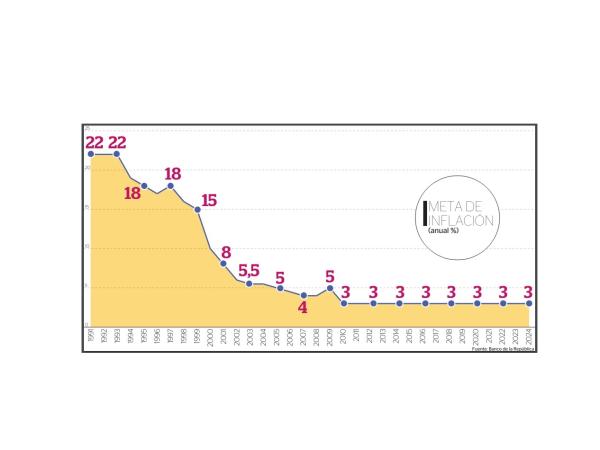The monetary adjustment processes The measures necessary to direct the economy to sustainable growth levels and control inflation often generate discontent in some sectors of the population. Naturally, in times of economic crisis and, above all, inflationary outbreaks that require increases in the interest rate, discontent arises among agents who are affected by the variation in the cost of financing, as well as by its impact on the economic activity.
In this context, One of the complaints against the monetary authority is the choice of the interest rate as an instrument to intervene in the economy.It is not unusual to hear voices wondering why the Bank of the Republic It ‘simply’ limits itself to raising (or lowering) the interest rate and does ‘nothing else’ to reduce inflation (or support recovery).
(You can read: What are the new types of illegal money raising?).
Some of these questions even suggest a certain easiness on the part of the Bank, perhaps evoking times when monetary policy financed the public and private sectors and intervened in the foreign exchange market on a recurring basis.
Inflation target.
However the constitutional mandate of the entity which prioritizes price stability in coordination with the performance of the economy, as well as the target inflation scheme used to achieve it, support the use of the interest rate as the main instrument of monetary policy.
(Read also: ‘Polls provide guidelines for financing electoral campaigns’: Figures & Concepts).
It must be remembered that the Political Constitution of 1991 It grants the Bank complete autonomy with the higher purpose of ensuring the maintenance of the currency’s purchasing power. In accordance with this objective, it establishes that it cannot issue money to grant credits or guarantees to individuals, and can only finance the State with the unanimous approval of the Board of DirectorsThese apparent limitations are, in fact, the necessary guarantee for the Bank to concentrate its efforts on maintaining price stability.
To achieve this objective, the Bank and most central banks around the world employ the strategy of target inflationThis scheme uses the interest rate as the main policy instrument, while allowing the exchange rate to float freely and capital flow without restrictions.
The basis of this strategy is the public announcement of a medium-term numerical inflation target, which constitutes the predominant guide to the central bank’s decisions. The monetary authority’s commitment to the published target implies that the interest rate will be used to achieve said target..

Bibiana Taboada.
A fundamental component of this regime, and one of its great advantages, is the transparency required by the central bank, which not only has to publish the inflation target with a certain periodicity, but must also report on its decision-making processes, forecasting models, projections of the main macroeconomic variables and operating procedures. In addition, It must have a clear and recurring mechanism of accountability to the State and society.
This institutional framework aims to make the inflation target a credible nominal anchor, that is, a reliable reference for the different economic actors. As this occurs and agents’ inflation expectations remain close to the announced target, Monetary policy becomes more effective and less costly.
(You may be interested in: Oil references receive July with price increases)
In the event of a temporary inflationary shock, the public knows that the central bank will act to return inflation to the announced targetso agents can keep their price expectations unchanged. This in turn allows the central bank to leverage its credibility and, with a moderate monetary policy reaction, ensure the return of inflation to the announced target.
This same one credibility and the anchoring of the inflation expectationsfacilitates the countercyclical reaction of monetary policy: In times of crisis, it can stimulate the economy by reducing the interest rate without causing major inflationary pressures, and in times of overheating, it only needs to make minor increases to the interest rate to control inflationary outbreaks.

Mauricio Villamizar-Villegas.
The Bank formally began using the inflation targeting scheme in 1999 after the country’s exchange rate liberalization process was completed. As shown in Chart 1, inflation targets fell consistently between 1991 and 2010, when the target of 3% per year was finally reached, within a tolerance range of plus or minus one percentage point, which has been maintained until today. The decision to maintain the target at a level of 3% for so many years is related to the advantages that such stability has in terms of the inflation rate. the establishment of a nominal anchor that is a credible reference for the different economic actors in their decision-making.
In conclusion, the choice of the interest rate as an instrument of monetary policy is not only consistent with the Bank’s constitutional mandate, but also results from the inflation targeting strategy on which monetary policy operates in Colombia and in many countries around the world. Although it is difficult to measure the concrete effectiveness of this strategy, The truth is that since its implementation, inflation levels have fallen significantly in the country..
(We recommend: Chilean economy grows 1.1% year-on-year in May, driven by mining).
In addition, the requirement of this scheme for greater transparency in the accountability process by the monetary authority has contributed to better communication with the public and to discipline the Bank’s decisions. This has contributed to the increase in institutional credibility.reducing the costs of monetary policy and allowing for countercyclical policy to reduce fluctuations in the economy and direct it towards sustainable levels in the long term.
Bibiana Taboada Arango and Mauricio Villamizar-Villegas
Co-directors of the Bank of the Republic.
*The opinions in this text do not represent the views of Banco de la República or its Board of Directors.
A more extensive version of this article is available at: https://www.banrep.gov.co/sites/default/files/publicaciones/archivos/nota-mitos-porque-utiliza-tasas.pdf













Add Comment